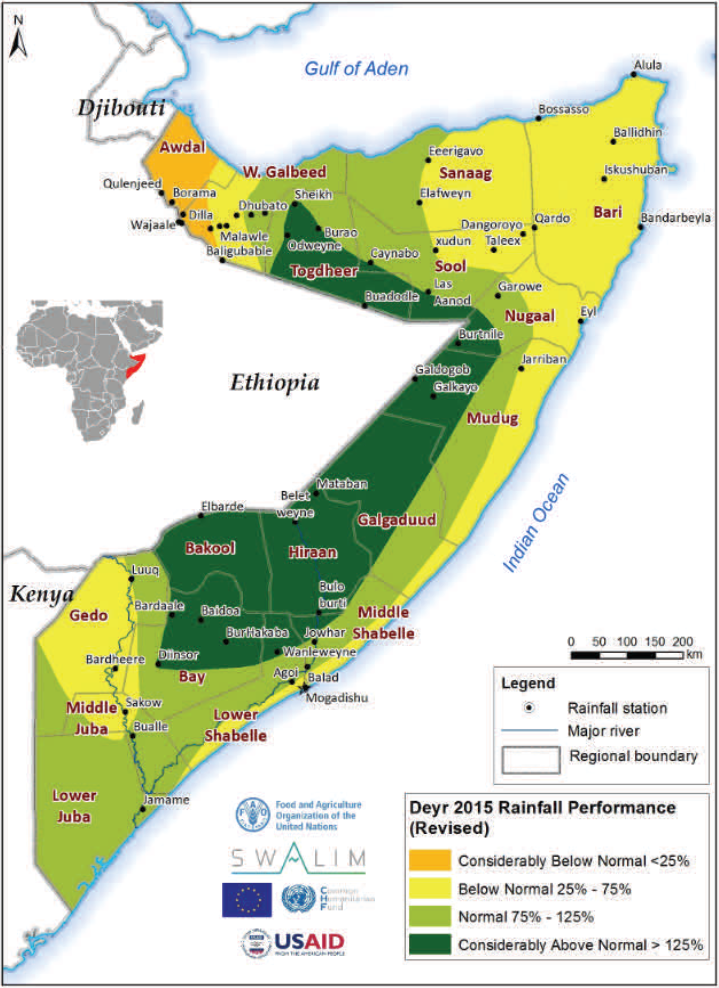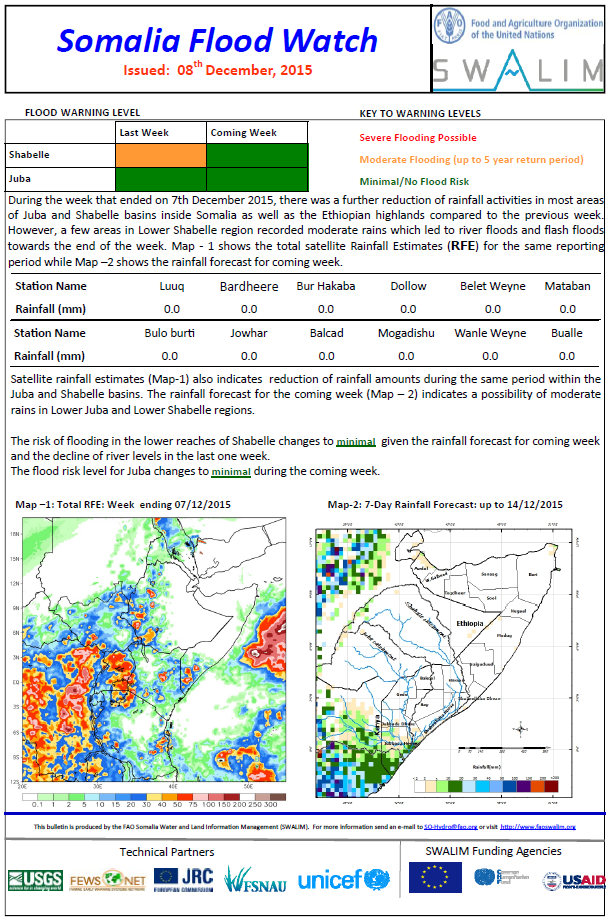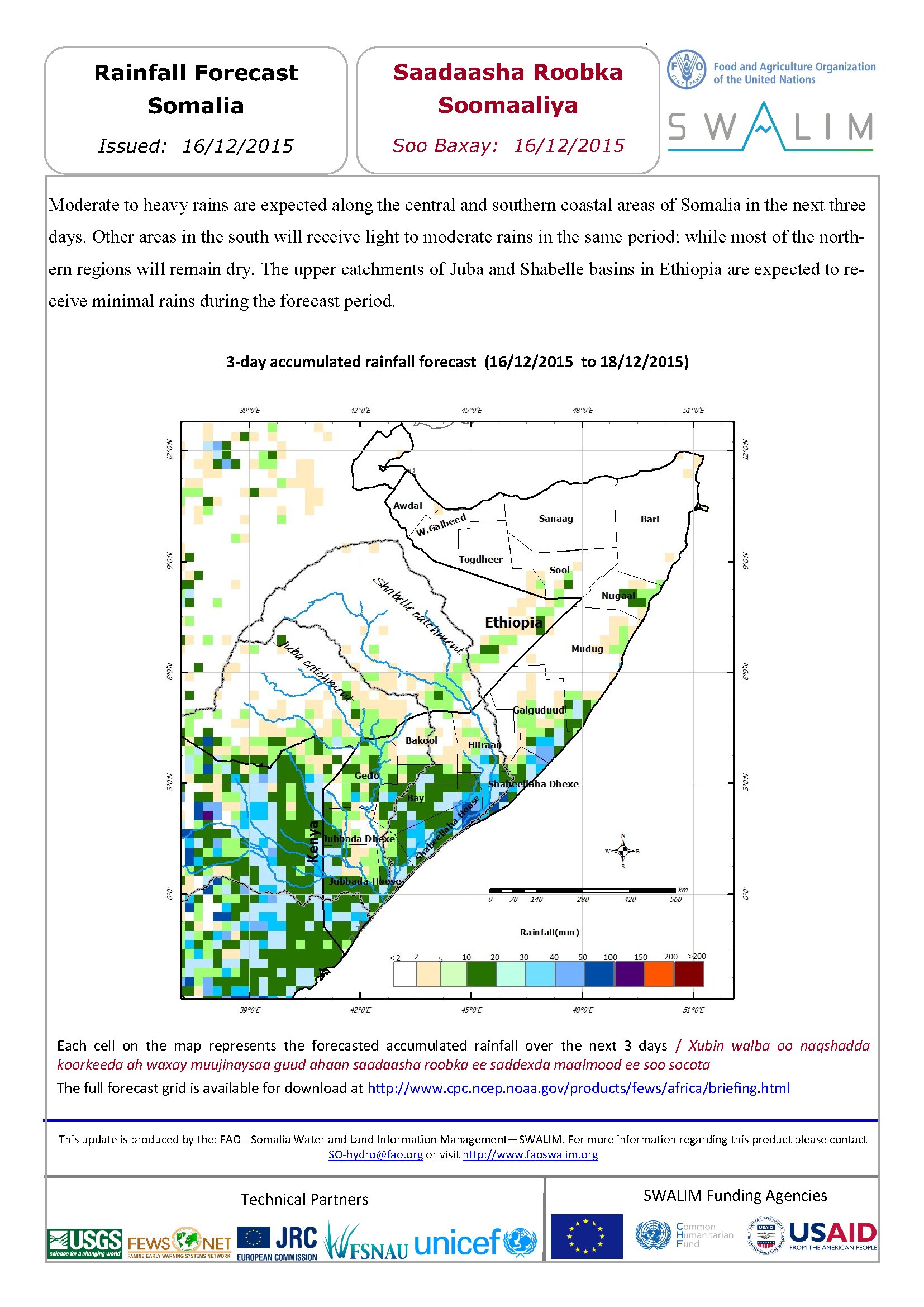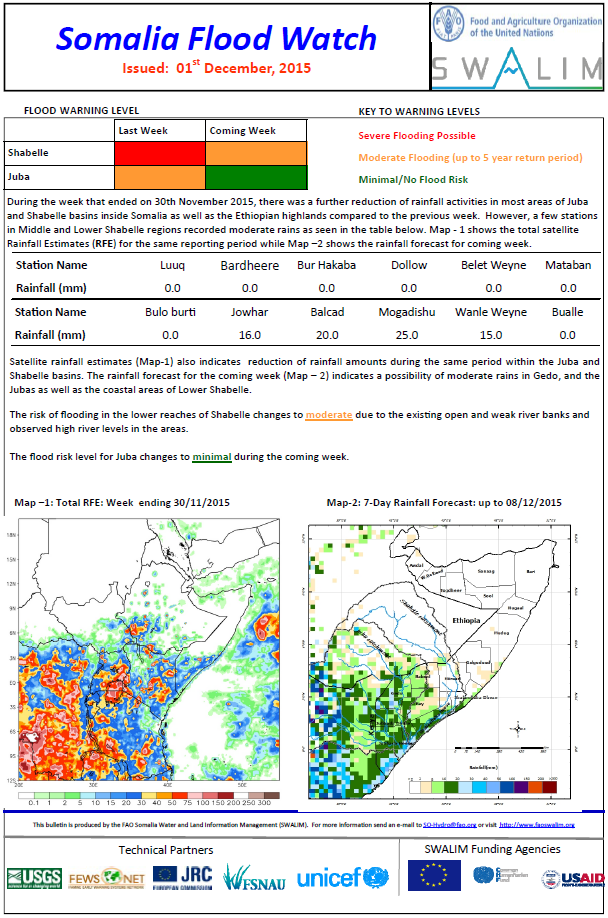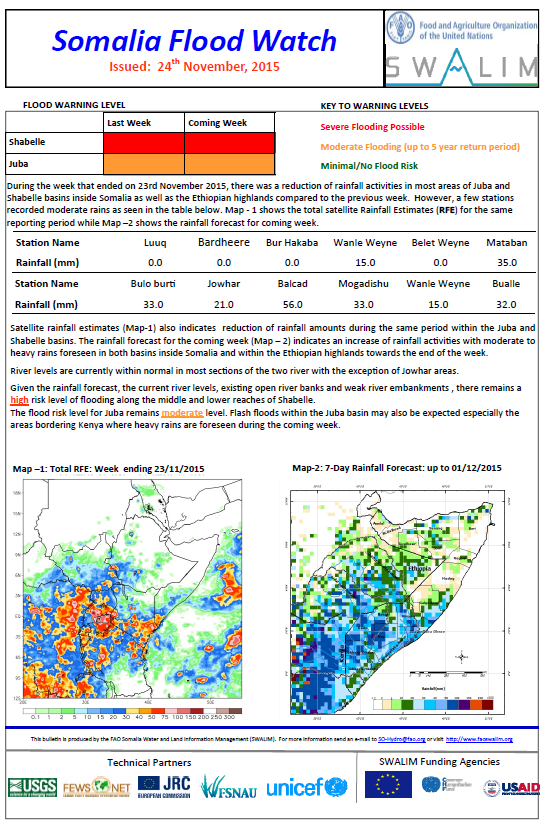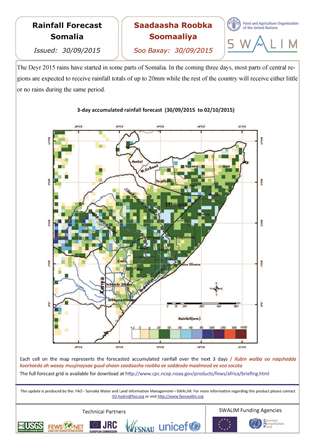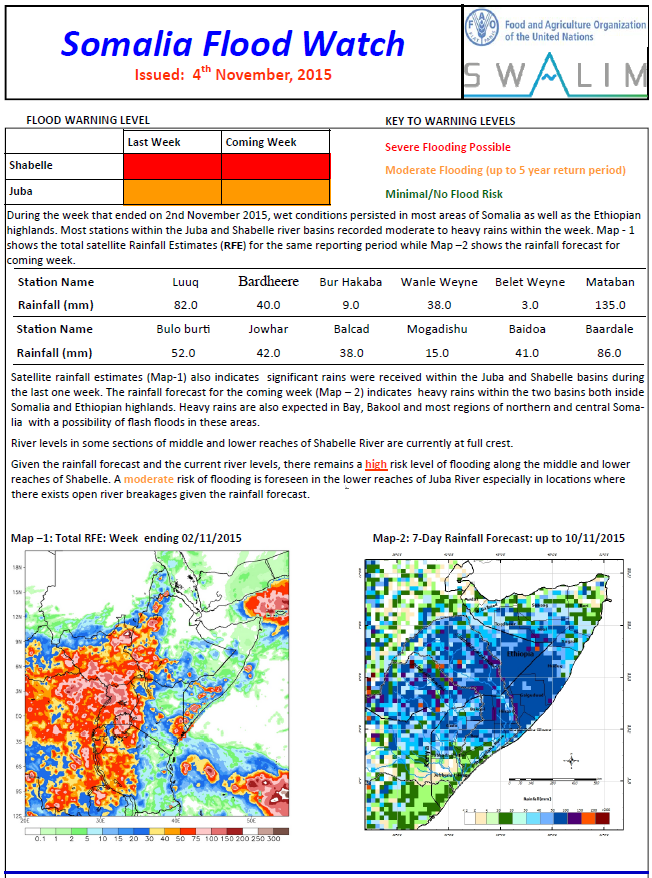Library Catalog
Latest Documents and Publications listed. Use search terms in the box below to find what you need
Drought Situation Update in Somalia - Feb 2016
The Deyr 2015 rainy season experienced El Nino conditions that resulted into good rains in many parts of the country. Despite this, the northern parts of the country are facing drought conditions. Two appeals for assistance have been sent by both the Somaliland and Puntland authorities. The drought conditions are as a result of failed consecutive rainy seasons especially in the western part of Somaliland. The situation is expected to worsen during the coming months owing to the continued depletion of available water resources in the areas. The next rainy sea-son is expected to start in late March.
Publication Type:
Drought watch
Publication Date:
Author:
Corporate Author:
Deyr 2015 Rainfall performance
The 2015 Deyr rainy season was generally good with many areas in Somalia recording normal to above normal rains with exception of the western parts of Somaliland, central Puntland and parts of Gedo region in the south that recorded below normal rains. The season started off well in early October in some areas and continued to spread spatially with a peak during the last two weeks of the month. In some parts of the South and central regions El nino phenomena caused very heavy rains leading to both flash floods and riverine flooding affecting over 140 000 people. The unusual heavy rains were also beneficial to most sectors. During the first week of November, the north eastern coastline was hit by two tropical storms (Chaplla and Megh) which led to loss of livestock and destruction of property. There were also cases of flooding along the storm path and close to 70,000 people were affected.
Publication Type:
Rainfall Performance
Publication Date:
Author:
Corporate Author:
W-27 Disaster Managemnet Plan for the Juba and Shabelle Basins in Somalia
This Contingency Plan articulates what the Federal Republic of Somalia Government through Disaster Management Authority (DMA) and with the support of partners will do to prevent or reduce any potential adverse impacts emanating from floods and drought disasters. Within this context, the Contingency Plan aims to prepare for and adequately respond to any of these common disasters when they evolve beyond the coping capacity of stakeholders.
It was developed through a participatory and inclusive multi-stakeholder process and aims to promote a coordinated approach to preparedness and response before, during and after disasters. In addition, the Plan is in line with provisions of the DMA Strategic Action Plan for 2016 that proposes to put in place an early warning system to help instill Disaster Risk Reduction (DRR) mechanisms in averting or minimizing the impact of disasters and also in the creation of effective emergency response and recovery plans.
One of the outcome of the training of Disaster Risk Reduction (DRR) and Early Warning (EW) held from 11th to 15th October 2015 in Mogadishu was the prioritization of key hazards likely to require contingency measures. These were identified as mainly drought and floods but with other minor ones such as land degradation, epidemics, conflicts, and pest infestation. The prioritized hazards identified in the Contingency Plan were developed with three scenarios. The most likely scenario envisages that there will be drought due to the failure of seasonal rainfall or flooding characterized with above normal rainfall in some parts of the country especially the Juba and Shabelle River Basins. As a result households will be affected and in both cases require assistance for a stipulated period of time.
Publication Type:
Technical report
Publication Date:
Author:
Corporate Author:
Flood Watch Bulletin 08-12-2015
During the week that ended on 7th December 2015, there was a further reduction of rainfall activities in most areas of Juba and Shabelle basins inside Somalia as well as the Ethiopian highlands compared to the previous week. However, a few areas in Lower Shabelle region recorded moderate rains which led to river floods and flash floods towards the end of the week.
Satellite rainfall estimates also indicates reduction of rainfall amounts during the same period within the Juba and Shabelle basins. The rainfall forecast for the coming week indicates a possibility of moderate rains in Lower Juba and Lower Shabelle regions.
The risk of flooding in the lower reaches of Shabelle changes to minimal given the rainfall forecast for coming week and the decline of river levels in the last one week. The flood risk level for Juba changes to minimal during the coming week.
Publication Type:
Flood watch bulletin
Publication Date:
Author:
Corporate Author:
Somalia Rainfall Forecast 16-12-2015
Moderate to heavy rains are expected along the central and southern coastal areas of Somalia in the next three days. Other areas in the south will receive light to moderate rains in the same period; while most of the northern regions will remain dry. The upper catchments of Juba and Shabelle basins in Ethiopia are expected to receive minimal rains during the forecast period.
Publication Type:
Rainfall Forecast
Publication Date:
Author:
Corporate Author:
Flood Watch Bulletin 02-12-2015
During the week that ended on 30th November 2015, there was a further reduction of rainfall activities in most areas of Juba and Shabelle basins inside Somalia as well as the Ethiopian highlands compared to the previous week. However, a few stations in Middle and Lower Shabelle regions recorded moderate rains.
Satellite rainfall estimates also indicates reduction of rainfall amounts during the same period within the Juba and Shabelle basins. The rainfall forecast for the coming week indicates a possibility of moderate rains in Gedo, and the Jubas as well as the coastal areas of Lower Shabelle.
The risk of flooding in the lower reaches of Shabelle changes to moderate due to the existing open and weak river banks and observed high river levels in the areas while the flood risk level for Juba changes to minimal during the coming week.
Publication Type:
Flood watch bulletin
Publication Date:
Author:
Corporate Author:
Somalia Dekadal Rainfall Bulletin - Dekad 33 2015
During the last dekad of November, (21st – 30th November 2015), there was a general reduction of rainfall activities across the country with most stations recording little or no rains. However, a few stations recorded moderate rains especially in Middle and Lower Shabelle Regions. Figure (1) shows the rainfall observational network and monthly rainfall distribution for selected stations across the country. This update will be issued every 10-days throughout the Deyr rainy season.
Publication Type:
Dekadal Rainfall Update
Publication Date:
Author:
Corporate Author:
Flood Watch Bulletin 24-11-2015
During the week that ended on 23rd November 2015, there was a reduction of rainfall activities in most areas of Juba and Shabelle basins inside Somalia as well as the Ethiopian highlands compared to the previous week. However, a few stations recorded moderate rains. River levels are currently within normal in most sections of the two river with the exception of Jowhar areas.
Given the rainfall forecast, the current river levels, existing open river banks and weak river embankments, there remains a high risk level of flooding along the middle and lower reaches of Shabelle. The flood risk level for Juba remains moderate. Flash floods within the Juba basin may also be expected especially the areas bordering Kenya where heavy rains are foreseen during the coming week.
Publication Type:
Flood watch bulletin
Publication Date:
Author:
Corporate Author:
Somalia Rainfall Forecast 16-11-2015
There will be a reduction of rainfall activities in most part of Somalia within the next three days. However, Gedo, Middle and lower Juba as well as the southern coastal areas are expected to receive light to moderate rains during the same period.
Publication Type:
Rainfall Forecast
Publication Date:
Author:
Corporate Author:
Flood Watch Bulletin 04-11-2015
During the week that ended on 2nd November 2015, wet conditions persisted in most areas of Somalia as well as the Ethiopian highlands. Most stations within the Juba and Shabelle river basins recorded moderate to heavy rains within the week.
Given the rainfall forecast and the current river levels, there remains a high risk level of flooding along the middle and lower reaches of Shabelle. A moderate risk of flooding is foreseen in the lower reaches of Juba River especially in locations where there exists open river breakages given the rainfall forecast.
Publication Type:
Flood watch bulletin
Publication Date:
Author:
Corporate Author:
Pages
 RSS feed [compliant with the Agris AP] |
RSS feed [compliant with the Agris AP] |  Agris AP XML
Agris AP XML



